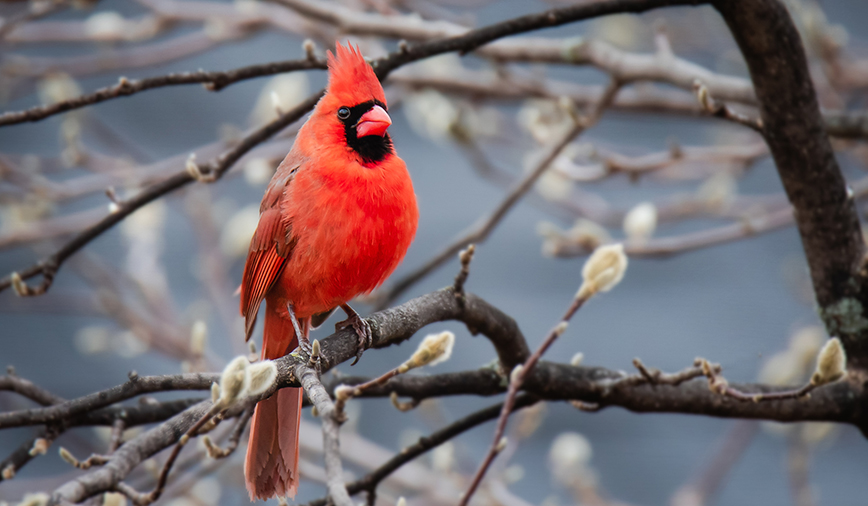March 20, 2015
Bird Sounds
What a difference a couple of weeks make.
When I last wrote about walking to work, my musings about nature were punctuated, early and often, by rude recalls back to the present. I slipped and slid, falling tail over teakettle twice during the nearly four-mile adventure before finally arriving, soggy but safe, at Hickory Knolls.
This week, though, was a completely different story. The warmer temperatures—with sunshine, to boot—made staying upright the entire way a virtual certainty. Even better, the glaciers that blocked my shortcuts had melted, cutting my journey by nearly 3/4ths of a mile.
With all systems go, I was able to concentrate fully on the sights and sounds around me. Tulips and daffodils were poking their leaves up, crocuses were blooming and–as a heads up for anyone who is allergic to tree pollens–the silver maples were blooming.
High overhead, the rattling calls of sandhill cranes wafted down to my ears. It took me a minute, but I finally spotted the large group, flying in V formation, heading in a north-by-northwest direction.
Closer to the ground, other birds were making noise too. Spring migration has sprung, with birds we haven’t seen in months now returning to their summer breeding grounds. Wasting no time, these species are singing up a storm, each intent on declaring and defending a breeding territory.
As my walk takes me through the west side of St. Charles, I was first able to listen to the neighborhood birds around Davis School, then Kehoe, a.k.a. “Rocket,” Park, then up Howard Street, and finally the birds along Oak Street as I approached Randall. I tuned in to their banter as I walked, and began counting species. Though I can’t replicate their songs exactly, here’s how birders remember them mnemonically:
American Robin: “Cheer up, cheerio, cheer up, cheerily”…over and over again
Northern Cardinal: “What-cheer, what-cheer, what-cheer,” or “Cheer, cheer, cheer;” also “Birdy, birdy, birdy,” which some people interpret as “Purty, purty, purty.”
Black-capped Chickadee: “Fee-bee,” or, the more fun, “Hey, Sweetie” Either way it’s a clear, two- or three-note whistle that is unmistakable, and quite different from the bird’s namesake “Chick-a-dee-dee-dee” warning call.
Mourning dove: “Hooo-ah, hoo-hoo-hoo.” Although their sound is definitely more of a coo than a hoot, these birds sometimes are mistaken for owls. The tip-off is when the songs occur. Doves are day shift, owls are night shift.
Song sparrow: These birds have so much to say, their mnemonic has three variations:
“Maids-maids-maids-put-on-your-tea-kettle-ettle-ettle;” or “Hip; hip; hip hurrah boys; spring is here!” or “Madge; Madge; Madge pick beetles off; the water’s
hot.” Personally, I hear “Sweet, sweet, sweet…blah blah blah yada yada.”
Blue jay: This sound was especially intriguing as I’m used to hearing blue jays in oak woodlands, not in my neighborhood of maples, locusts and lindens. When I saw where the bird was sitting—in a yard full of birdfeeders—its presence made more sense. Blue jays make a number of sounds in addition to their characteristic “Jay, jay” jeer; the call I heard is one I learned as the “rusty pump,” because its squeaky tones sound very much like the handle of a water pump in need of some oil. But this sound also is sometimes given the mnemonic, “Tweedle dee.”
The blue jay’s racket got me to thinking about the different reasons birds make sounds. The jay’s calls had little to do with declaring territory, but were instead a means of expressing alarm or warning—as if I wanted anything to do with the peanuts he appeared to be guarding. (Well, actually…)
When birds sing, that is, make complex and musical sounds, they usually are doing to as a means of finding and communicating with a mate, and/or claiming and protecting a territory. Usually, but not always, the task of singing falls to the male.
Calls, however, deliver other types of messages. Typically shorter and not as tuneful, they are used to express excitement, distress and/or aggression, to name just a few of their varied functions.
Some birds make contact calls just to “stay in touch.” Thinking back to the northern cardinal, its song, the “Birdy, birdy, birdy” and its variations, typically are sung from the tops of trees or other prominent objects—just the sort of places you’d expect a bird declaring its territory to sing from. But the softer “Chip” call is often emitted from more concealed locations, like the branch of a shrub.
If you, like me, have been tuning in to the sounds of spring, and would like to learn more about what all these songs mean—and who is making them—you might want to mark your calendars for Saturday May 16. That day, from 8-10am, members of Kane County Audubon will be leading a learning adventure called Birding By Ear.
As the description for this free program notes, “On any given day in spring, you likely will hear more birds with your ears than you will be able to see with your eyes.” After instruction on local species and the sounds they make, the group will take a walk around the Hickory Knolls Natural Area to practice their newfound skills.
Unless the weather takes a giant leap backward, the trails will be ice and snow free, and spring will be in full swing. We’ll be listening that day, but also watching. Hope to see YOU there!
Pam Erickson Otto is the manager of nature programs and interpretive services at the Hickory Knolls Discovery Center, a facility of the St. Charles Park District. She can be reached at 630-513-4346 or potto@stcparks.org.

